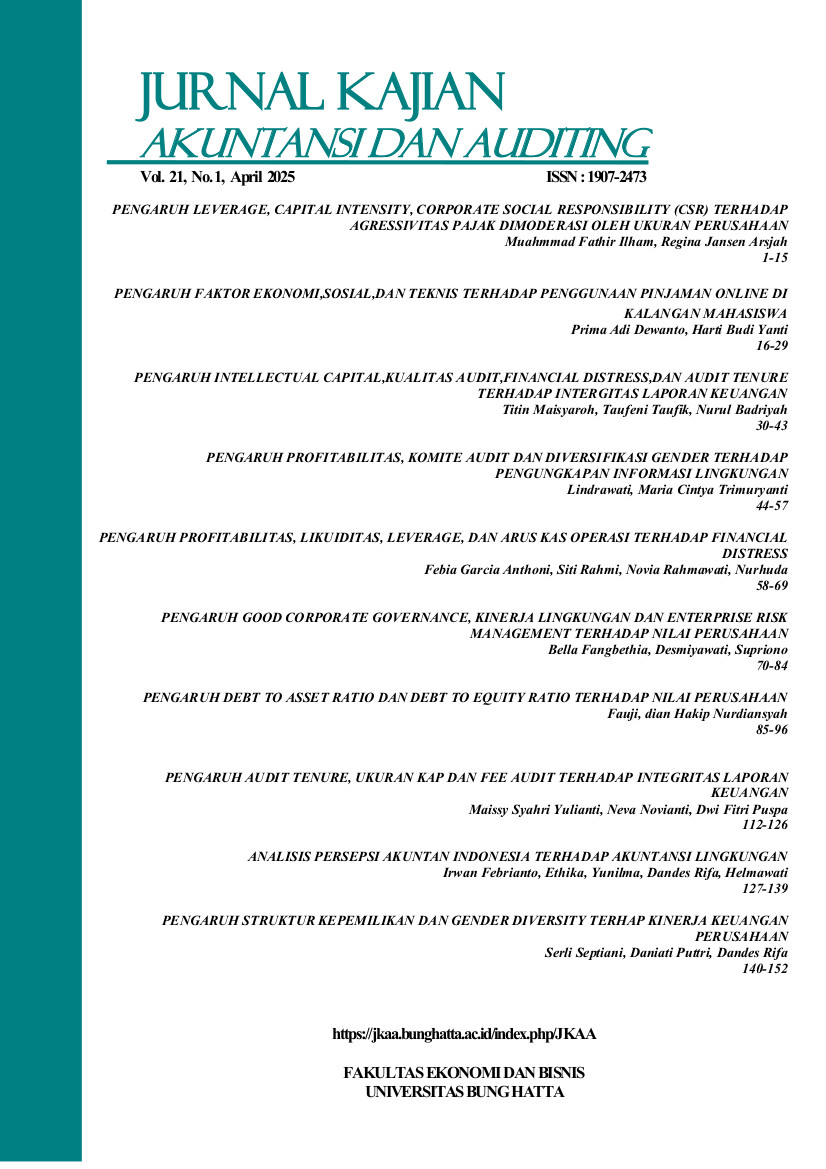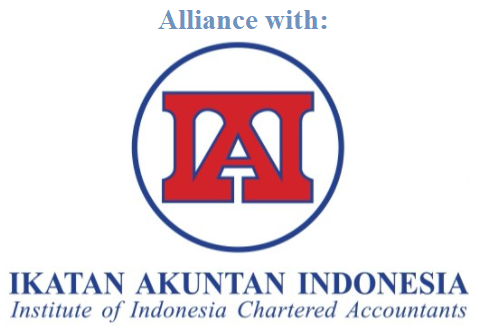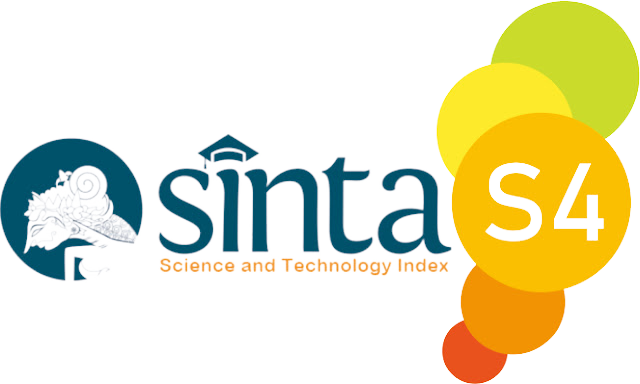PENGARUH DEBT TO ASSET RATIO DAN DEBT TO EQUITY RATIO TERHADAP NILAI PERUSAHAAN
DOI:
https://doi.org/10.37301/jkaa.v21i1.161Keywords:
Price to book value, Debt to asset ratio, Debt to equity ratioAbstract
The rapid development of technology presents a significant challenge for entities in Indonesia. This is primarily due to the expectation that technological advancements should be accompanied by an increase in human resource capabilities. In addition, there are adverse effects that may arise, particularly for entities within the media industry sub-sector. One such impact is the growing public interest in video streaming services, which may affect the Firm Value. This study aims to examine the effect of the Debt to Asset Ratio (DAR) and the Debt to Equity Ratio (DER) on Firm Value, both partially and simultaneously. The research focuses on DAR and DER within media industry sub-sector entities to assess whether the assets and equity owned by these entities are sufficient to meet their liabilities, and whether increases in these financial ratios have an impact on Firm Value. A quantitative research method was employed, with the population and sample comprising entities from the media industry sub-sector listed on the Indonesia Stock Exchange (IDX) for the 2021–2024 period. The results of this study indicate that both the Debt to Asset Ratio and the Debt to Equity Ratio have a significant influence on Firm Value, whether measured individually (partially) or collectively (simultaneously).
References
Alya Dwi Yuliani, & Oji Kurniadi. (2023). Peranan Media Streaming dalam Menggantikan Televisi Konvensional di Kalangan Masyarakat. Jurnal Riset Manajemen Komunikasi, 3(2), 109–114. https://doi.org/10.29313/jrmk.v3i2.3140
Anggriani, A., & Amin, M. N. (2022). Pengaruh Good Corporate Governance, Kinerja Keuangan Dan Ukuran Perusahaan Terhadap Nilai Perusahaan. Jurnal Ekonomi Trisakti, 2(2), 883–892. https://doi.org/10.25105/jet.v2i2.14739
Arrahman, A., Murni, S., & Mangantar, M. (2023). Pengaruh Return on Asset, Debt To Asset Ratio Dan Debt To Equity Ratio Terhadap Nilai Perusahaan Pada Perusahaan Building Construction Di Bursa Efek Indonesia. Jurnal EMBA : Jurnal Riset Ekonomi, Manajemen, Bisnis Dan Akuntansi, 11(3), 39–50.
Chandra, D. S. (2021). Pengaruh Debt To Asset Ratio, Return On Asset Earning Per Share Terhadap Harga Saham Pada Perusahaan Farmasi Yang Terdaftar Di Bursa Efek Indonesiaperiode 2015-2019. Jurnal Akuntansi Dan Keuangan Kontemporer (JAKK), 99–108. https://doi.org/10.30596/jakk.v4i1.6906
Fajriah, A. L., Idris, A., & Nadhiroh, U. (2022). Pengaruh Pertumbuhan Penjualan, Pertumbuhan Perusahaan, Dan Ukuran Perusahaan Terhadap Nilai Perusahaan. Jurnal Ilmiah Manajemen Dan Bisnis, 7(1), 1–12. https://doi.org/10.38043/jimb.v7i1.3218
Jaya, E. P., & Kuswanto, R. (2021). Pengaruh Return on Assets, Debt To Equity Ratio Dan Price To Book Value Terhadap Return Saham Perusahaan Lq45 Terdaftar Di BEI. Jurnal Bina Akuntansi, 8(1), 51–67. https://wiyatamandala.e-journal.id/JBA/article/view/136
Jie, L., & Pradana, B. L. (2021). Pengaruh Debt To Asset Ratio, Return on Asset, Total Asset Turnover Dan Current Ratio Terhadap Pertumbuhan Laba Perusahaan Manufaktur Sektor Industri Barang Konsumsi Terdaftar Di Bei Periode 2016 – 2019. Jurnal Bina Akuntansi, 8 (1), 34–50. https://doi.org/10.52859/jba.v8i1.135
Kirana, A. Y., Saifudin, M., Mukhlisin, M. M., Fatmawati, N., & Ansori, M. I. (2023). Transformasi Digital terhadap Sumber Daya Manusia sebagai Upaya Meningkatkan Kapabilitas Perusahaan. Digital Bisnis: Jurnal Publikasi Ilmu Manajemen Dan E-Commerce, 2(4), 19–36. https://doi.org/10.30640/digital.v2i4.1707
Leni Siti Rukmana Deffi, Dwi Cahyono, & Rendy Mirwan Aspirandi. (2017). Pengaruh Enterprise Risk Management Disclosure Intellectual Capital Disclosure Dan Debt to Asset Ratio terhadap Nilai Perusahaan (Studi Empiris Pada Perusahaan Pertambangan yang Terdaftar di Bursa Efek Indonesia Tahun 2015-2017). 11(1), 92–105.
Ningrum, E. P. (2022). Nilai Perusahaan (Konsep dan Aplikasi). In Angewandte Chemie International Edition, 6(11), 951–952. (Vol. 3, Issue 1). https://medium.com/@arifwicaksanaa/pengertian-use-case-a7e576e1b6bf
Oktiwiati, E. Dela, & Nurhayati, M. (2020). Pengaruh Profitabilitas, Struktur Modal, Dan Keputusan Investasi Terhadap Nilai Perusahaan. Mix: Jurnal Ilmiah Manajemen, 10(2), 196.
Priyatama, T., & Pratini, E. (2021). Pengaruh Struktur Modal, Profitabilitas, Likuiditas, dan Ukuran Perusahaan terhadap Nilai Perusahaan (Studi Empiris pada Perusahaan Infrastruktur, Utilitas, dan Transportasi yang Terdaftar di Bursa Efek Indonesia Periode 2015-2018). Eksis: Jurnal Ilmiah Ekonomi Dan Bisnis, 12(1), 100. https://doi.org/10.33087/eksis.v12i1.242
Purba, R. B. (2020). Teori Akutansi: Sebuah Pemahaman untuk Mendukung Penelitian di Bidang Akuntansi Cetakan. In Jurnal Ilmu Pendidikan (Vol. 7, Issue 2).
Sembiring, L. D. (2021). Analisis Laporan Keuangan.
Sugiyono. (2020). Metode Penelitian Kuantitatif dan Kualitatif.
Tambuwun, C. E., Mangantar, M., & Rumokoy, L. J. (2024). Pengaruh Debt To Equity Ratio, Earning Per Share, dan Return on Aset Ratio terhadap Nilai Perusahaan Sub Sektor Jasa Kesehatan yang Terdaftar Di BEI. Jurnal EMBA, 12(01), 107–115. www.idx.co.id.
Wijaya, A. M. (2022). Pengaruh Profitabilitas, Sales Growth, Leverage, dan Likuiditas terhadap Tax Avoidance (Studi Kasus pada Perusahaan Manufaktur Sub Sektor Industri Otomotif dan Komponen yang Terdaftar di Bursa Efek Indonesia Tahun 2015-2021). Braz Dent J., 33(1), 1–12.
Downloads
Published
Issue
Section
License
Please find the rights and licenses in Jurnal Kajian Akuntansi dan Auditing (JKAA). By submitting the article/manuscript of the article, the author(s) agree with this policy. No specific document sign-off is required.
1. License
The non-commercial use of the article will be governed by the Creative Commons Attribution license as currently displayed on Creative Commons Attribution-NonCommercial 4.0 International License.
2. Author(s)' Warranties
The author warrants that the article is original, written by stated author(s), has not been published before, contains no unlawful statements, does not infringe the rights of others, is subject to copyright that is vested exclusively in the author and free of any third party rights, and that any necessary written permissions to quote from other sources have been obtained by the author(s).
3. User/Public Rights
JKAA's spirit is to disseminate articles published are as free as possible. Under the Creative Commons Attribution-NonCommercial 4.0 International License, JKAA permits users to copy, distribute, display, and perform the work for non-commercial purposes only. Users will also need to attribute authors and JKAA on distributing works in the journal and other media of publications. Unless otherwise stated, the authors are public entities as soon as their articles got published.
4. Copyrights Holder
With the receipt of the article by Editorial Board of the Jurnal Kajian Akutansi dan Auditing (JKAA) and it was decided to be published, then the copyright regarding the article will be diverted to Jurnal Kajian Akutansi dan Auditing (JKAA).
Jurnal Kajian Akutansi dan Auditing (JKAA) hold the copyright regarding all the published articles and has the right to multiply and distribute the article under

















